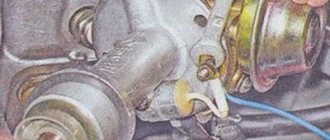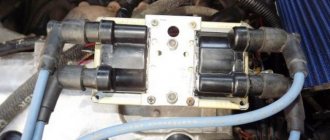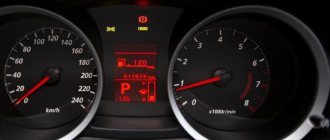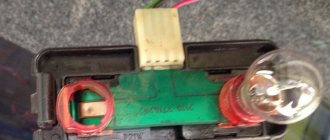The reasons why the spark disappears on a VAZ-2109 carburetor type car may be the following:
- faulty Hall sensor;
- the switch burned out;
- break in the ignition coil;
- high-voltage wires are worn out;
- the candles became unusable;
- The timing belt is worn.
From the very beginning, if the disappearance of the spark is detected, you should review all contacts and the condition of the electrical wiring. If you find oxidation on the connector, it must be cleaned with sandpaper and rechecked for the presence of a spark. High-voltage wires should be checked for integrity using a special device - a tester.
A breakdown in the ignition switch can be diagnosed using a standard automotive lamp. One of its contacts must be connected to the body body or carburetor engine 2109, and the second contact must be connected to wire “B+” from the ignition coil. If the light is on, this indicates that the ignition switch is working properly. In this case, you need to go to the ignition coil.
The serviceability of the Hall sensor can be checked using a voltmeter or, again, a light bulb. At the moment the distributor rotates, the filament in the light bulb should change the intensity of the glow.
The simplest way to check for proper ignition of carburetor VAZ-2109
If there is no spark in the car, you can find the reasons in another way. This technique does not require the use of a special device or tool. In this method, the entire ignition chain is tested, without taking into account the Hall sensor. To carry out this work, we need a small wire with insulated ends and a nail or paper clip.
First of all, we disconnect the high-voltage cable from the distributor. During checking, it must be positioned approximately 10 millimeters from the minus of the car. Next, turn on the ignition. Disconnect the connector from the Hall sensor and connect its end to the middle contact, to which the green wire is connected. We short the other end of our wire several times to ground. At the moment of short circuit, sparks should run between the ground and the end of the wire. If there is a spark in a carburetor VAZ-2109, we can conclude that the Hall sensor is faulty or there is no contact. Often, inside the distributor itself, the plate frays the wires or the connector simply becomes loose. In addition, there are cases when, when checking, we see the presence of a spark, but when connecting the wire to the spark plug caps, there is no spark. This indicates the need to replace the slider inside the distributor. Some carburetor-type VAZ-2109 are equipped with an ignition interlock circuit, which may also become unusable (or there is a malfunction in the switch).
Before performing the test, you need to prepare the following set of tools:
- figured and flat screwdrivers;
- insulated pliers;
- control with a wire or tester;
- spare spark plug.
To protect yourself from electric shock, you should wear dielectric gloves.
Verification process:
- We turn off the ignition, after which we check the high-voltage wires for breaks, and at the same time check for good contact in the connections with the distributor and the ignition coil.
- We carefully inspect the condition of the wires between the distributor and the switch, and also check the wires from the ignition coil to the switch.
- With the ignition switch on on a carburetor VAZ-2109, you need to check the presence of power in the system. To do this, take a test lamp, connect one end to ground, and the other to the “B+” contact of the coil. The glow of the control lamp indicates the presence of power.
- Using a rubber glove, disconnect the middle high-voltage wire from the distributor. We put a spark plug into its tip and touch the engine ground with the metal part. When cranking the starter, sparks should flow from the spark plug.
- Unscrew the screws of the distributor and remove its cover. We check for cracks and damage, and also check the condition of the coal. If the cover is damaged or cracked, it must be replaced.
- We inspect the condition of the slider in the distributor. Quite often it happens when there is no spark due to a breakdown of the interference suppression relay or breakdowns in the housing of the ground slider.
- We check the crankshaft by rotating the starter. If the slider is stationary, the reason for this is a broken timing belt or the drive itself is faulty.
- We check again for the presence of a spark.
- If once again there is no spark in a VAZ-2109 carburetor type car, you should check the high-voltage ignition wiring, as well as the spark plugs themselves. To do this, you must use a known good spark plug. If there is still no spark, change the high-voltage wire.
Stage one
Usually the symptoms of difficulty are the following: the starter rotates regularly in its own standard mode, but the engine does not want to start. One of the most possible circumstances is a fuel pump that does not start. When on injection “tens” it is submersible and is located directly in the tank.
There is an option to check the element by the presence of operating sound. Turn on the ignition - there should be a rumble in the area of the rear seats. He is absent from time to time. In our version, you should check the fuses. The VAZ-2110 is a fuel-injected car, and the fuse box is located on the side of the center console of the unfamiliar front passenger. You need to unscrew the fasteners, then remove the cover, check the fuses for functionality and change them as necessary. In this case, the elements are 100% serviceable, then you need to check whether the relay will turn on, both the main one and the fuel pump. Of course, you can feel the moment of switching on with your finger. A corresponding click will also be heard.
If the fuel pump is operational, use a pressure gauge to check the presence of fuel there. If there is no pressure gauge, then press on the spool at the bottom of the fuel rail. myth element may be in a protective cap. The pressure will be completely tangible, although its power cannot be found. A running pump and no pressure indicates an obstruction in the fuel line. This is caused by a clogged fuel filter.
No spark VAZ 2109 carburetor reasons
The carburetor "nine" does not produce a spark. Why does this happen and what to do? If there is no spark in the VAZ 2109 carburetor, the reasons lie either in the malfunction of one of the elements or in the wiring that connects them. You can independently identify the cause of the unit failure. To troubleshoot, you will need an assistant to turn on the ignition. You will need a multimeter, as well as spare parts (switch, Hall sensor). To find a breakdown, you need to understand the sequence of connecting the circuit elements and at least in general know the principle of the appearance of a spark on the spark plugs. Let's look at it and check all the devices for functionality.
Why is car diagnostics necessary?
Judging by everything written above, we can conclude that searching for a problem takes a huge amount of time and spends a lot of effort. In order not to let this happen and to save on possible repairs in advance, it is necessary to carry out regular diagnostics of the vehicle.
Unfortunately, this cannot always be done through a service station, since:
- They ask a lot of money for standard diagnostics.
- You need to go to professionals if a serious problem arises.
- Finding workers who have experience in solving the problems that arise is quite difficult.
It also happens that after diagnostics are carried out at an unverified service station, additional repairs are required.
A good way to solve the problem of inspecting a car is to purchase an ELM327 auto scanner. The device can connect to any car, and the test is carried out using a mobile phone. This will not only allow you to identify the fault in time, but will also save money.
How a spark is formed on a candle
By turning the key in the ignition, you turn the starter. Its function is to engage the gear with the flywheel to transmit torque to the flywheel. As soon as the parts are engaged, the moment is transferred - the key returns to its place. And during this time, while the key was turned, a number of processes should occur, as a result of which a spark appears on the candles.
The flywheel itself is mounted on the crankshaft and rotates it. From the crankshaft through the timing belt, rotational motion is transmitted to the camshaft. Simultaneously with the camshaft and at the same frequency, the shaft on which the distributor slider (ignition distributor) is located rotates. The cylindrical screen rotates and an electromagnetic field (EMF) is generated, the voltage value of which is read by a Hall sensor. Next, the switch comes into operation. This device converts the voltage to the required value and transmits it to the primary winding of the ignition coil.
An electromotive force is generated inside the coil and exits through the central electrode. From here the pulse is supplied to the central wire of the distributor, to which 4 spark plugs are connected. The distributor rotates, making contact with each of the spark plugs in turn. The spark plugs are screwed into the cylinder head, their electrodes are located in the combustion chamber.
As a result of a short circuit on the spark plugs, a voltage of 10–15 kV is achieved. This is enough for a spark to occur between the central and side electrodes of the spark plug.
Device Features
The ignition coil serves to produce a spark coming from the spark plug electrodes. To put it briefly and simply, this is a small transformer that operates in pulse mode and converts 12 volts from the car into 20-30 thousand volts at the output. High-voltage wires are used to transmit the impulse, which also sometimes cause coil malfunctions.
The distributor-type ignition system works simply - the distributor (distributor) receives a low-voltage pulse from the car's network, transmits it to the coil, and it, in turn, transforms the pulse into a high-voltage pulse. Next, the distributor distributes sparks among the cylinders depending on the order of their operation.
Structurally, the VAZ 2109 coil consists of a pair of windings - secondary and primary.
- The primary winding has fewer turns, but wires with a larger cross-section;
- The secondary winding of a coil with a large number of turns, but a smaller wire cross-section.
Windings
Signs of breakdown
Often the spark at the carburetor disappears unexpectedly when the driver is not prepared for such a turn of events. But if you have enough experience and pay close attention to the behavior of your car, you can detect signs of a malfunction before the spark disappears and the engine does not start.
So, why does the spark disappear, what are the reasons and what signs may indicate a failure of the ignition coil?
Approximately 500 kilometers before the coil’s life is over, on a cold engine the device normally starts working only after a couple of minutes of warming up. The engine starts with difficulty, but some people think that the problem is in the idle system. At the same time, the engine begins to behave unstably at low speeds.
This phenomenon occurs within 10-30 seconds, so you don’t always have time to pay attention to it. Another short-term symptom is the engine actively shaking when starting a cold engine and holding down the gas pedal. This will happen literally for 3-5 seconds, and after pressing the pedal again, everything will return to normal. When accelerating or changing gears at the gearbox, the engine may produce jerks, vibrations, and the dynamics deteriorate for a short time
The downside is that such a symptom may appear for a few moments, but disappears just as quickly. The most obvious sign is the complete failure of the engine to try to start. The spark disappears, and therefore the chances of starting are zero.
Article on the topic: Installing front strut struts on a VAZ 2114, which one is better to install and is it worth it?
The main reasons for the lack of ignition
The principle of operation is clear. All malfunctions of the VAZ 2109 ignition system are associated with the failure of one of the above elements. If there is no spark on the VAZ 2109 carburetor, it means there is a malfunction:
- switch;
- Hall sensor;
- timing belt;
- ignition coils;
- ignition switch contact groups;
- distributor cover contacts;
- candles (“drenched”, burnt);
- circuit wiring.
If the commutator is faulty, then the voltage value to the coil is not converted. A failed Hall sensor does not supply current to the switch. If the timing belt breaks, the operation of the system is disrupted and EMF is not generated. A broken coil stops the chain moving on itself, the distributor contact does not receive voltage. Damaged distributor cover contacts prevent voltage from being applied to the spark plug.
The spark plug electrodes may not produce a spark due to carbon deposits or moisture on them. It happens that the culprit is the first element of the circuit: the ignition switch. A breakdown in its contact group does not start the starter. It is also possible that a banal damage to the wiring has occurred, causing the connection of the elements to disappear.
If there is no spark in the VAZ 2109 injector, the process of finding a breakdown is much more difficult. After all, the design of the system requires the presence of a separate ignition module controlled by the ECU.
Communities › UAZ drivers › Blog › Doesn’t start (very bad spark)
Good evening! I have a UAZ 31512. I took it recently, I want to make it for myself, I haven’t registered it here yet. Today, for no apparent reason, the UAZ suddenly stalled. Attempts to start it up were unsuccessful. I turned out the spark plugs and checked the spark, the spark is very weak and not constant. I changed the spark plugs a week ago for new ones, checked on the old spark plugs and the spark was also very weak and not constant. The distributor cover is new, I don’t know what else could be the reason, I’m not good at electrics. In the end, they dragged me home using a tie. Where to climb and what to dig in? And most importantly, how much money can this cost?
Comments 40
An electrician came today. The problem was found, the carburetor throws so much fuel that it floods the spark plugs, today I bought new spark plugs, installed them and the UAZ started. Now we need to find a good carburetor specialist.
What kind of ignition? Contact or non-contact?
If only I knew =) How to distinguish contact from non-contact?
I checked the ignition and it's contactless. What is the approximate cost of ignition ATE-2 on UAZ? And is it difficult to replace it?
Today we installed such a system, a distributor on the hall sensor, a 2108 coil and a commutator, set it up with a scrubscope, new armor plates and spark plugs, but bad luck, there is no idle only on the suction, what to do, the carb was adjusted half a year ago, do it again.
After aligning the distributor with the strobe light to the mark, you must also tighten it manually. And yes, how did everything work before the replacement?
I don’t know how to say it, in general, I had an underwater ignition and everything seemed to be humming, but the distributor began to stand out and rattle from it, as a result, on the trip it started grinding again, I took it off and twisted it a little and anointed it, but it stopped smoking, the spark plugs turned black and I decided no longer worry about this ignition and installed this, as I wrote above, today we rehearsed the carb, began to drive and keep it idle, but when you remove the armor from the spark plug, 1.2 stalls and 3 does not react, it’s kind of weak, 4 is also not to say that they were The changes are just a little bit, they did the head but one valve is rattling, in general something like this.
It's not a crime to rattle a valve. A squeezed one is evil, it can burn out. Black spark plugs = too much fuel, lighter has nothing to do with it. The intake manifold gasket needs to be soaked with water. Carb gasket too, by the way. And throttle shafts. And the engine should not shake at all at idle. And if you put your hand to the exhaust, there should be no spitting either at idle or at speed. I would put the lighter on a little later and look at the carb, it looks like it makes some kind of bodyagu instead of a mixture.
howling today I tested the adjusted carb and ignition, I didn’t start it right away in the morning, but I started it, warmed it up and drove off, the engine’s performance is much better, it pulls not bad either, the only thing is that when you press the gas sharply, it seems to stall or choke slightly and again the speed is normal, The car runs not bad, only today I noticed a new problem, the fuel pump was baked and as it turned out it was crooked on the plane, I had to straighten it and remove the rod by knocking out the cotter pin, but it was filled with paraffin or something, and I assembled everything and this rod was not closed with anything, and now Today I went uphill and the car stopped, somehow I came down and opened the hood, I looked and there was no gas in the filter, I started pumping and then I saw the rod came out and apparently it wasn’t pumping, the rod was driven in and sealed with sealant, in general, so far everything is working.
Failure when pressed sharply - the accelerator pump in the carb or twist the lighter. At the same time, the consumption will decrease - the cars don’t move, we press the pedal more, the consumption increases, but there is little sense.
We start checking with the coil
The high-voltage discharge comes from the ignition coil, so we check it first. Do not try to start the car more than three times, because you can drain the battery, and it is needed when performing the test. The coil is diagnosed as follows.
- We take out the armored wire from the distributor cover.
- We put on gloves or pick up pliers.
- We bring the contact of the high-voltage wire to ground.
- The second person turns on the ignition.
If a large blue spark appears, then the coil produces a discharge, everything is in order with it. The absence of a flash or a weak spark indicates that the problem is either in the coil itself or in the elements that go in the circuit before it. We check the functionality of the coil, switch, Hall sensor, and ignition switch.
| Stages of work | Actions |
| First you need to check the high-voltage wire for integrity. | We set the multimeter slider to 20 kOhm, bring the probes to the opposite contacts of the wire. The device should show a resistance of 3.5–9 kOhm. If the value is greater or less, replace the wire. |
| If the readings on the screen are normal, we test the coil. First, the resistance of the primary winding is checked. | To do this, we connect the tester probes to terminals B and K on the coil. We set the tester to 20 ohms. The reading on the screen should be between 0.4 and 0.5 ohms. |
| To check the secondary winding, move the probe from terminal K to the high-voltage output. | The multimeter slider is 20 kOhm. The norm on the screen is 4-5 kOhm. If there are deviations from normal values, replace the coil. |
If the readings are in order, we look further for why the spark disappears on the VAZ 2109 carburetor.
High voltage wires
It doesn’t often happen that all the wires fail at once, but they still need to be checked. The functionality is determined by disconnecting each one in turn and measuring the resistance. In good condition, the resistance value, including on the main conductor, should be within the range of 2.7-9 kOhm. If deviations are detected, faulty elements must be replaced.
It will not be superfluous to check the so-called “coal”, that is, the graphite contact of the wire. If it is damaged, no voltage is supplied to the slider and all spark plugs will be de-energized.
Based on the list of common problems that cause the “nine” to lose spark, it is clear that this car is not very complex in terms of effort and time. It is enough to have a basic set of knowledge and a set of tools - and the car is ready to travel again.
Checking the switch, Hall sensor and ignition switch
Back along the circuit from the coil there is a voltage conversion switch. This device cannot be checked using a multimeter. Therefore, it is necessary to test replace the old switch with a new one. It is recommended to carry a spare device with you in such cases. If the reason was precisely the breakdown of the switch, then with the new device a spark should appear. If it is missing, the breakdown must be looked for elsewhere.
Perhaps the Hall sensor is faulty, which is why there is no spark on the VAZ 2109 carburetor. It will also not be possible to check it using a tester. We do the same as with the switch - install a new one. The difficulty is this: to get to the sensor, you need to disassemble the distributor.
If replacing the sensor does not produce results, we check the ignition switch. We set the multimeter to 20 V. Connect one probe to terminal B, the second to ground. If the battery is charged, the tester should show 12 V. If the voltage is significantly less, there is an open circuit in the lock contact group: either the wire is broken or the fuse is blown.
We look for the problem or completely replace the lock.
What to do
If the engine runs or starts poorly, motorists are interested in how to strengthen the spark on the spark plugs. First, you need to establish the cause of the breakdown by checking the previously mentioned components and elements using a multimeter and visual inspection. Many faults can be seen by eye.
Often, a simple replacement of spark plugs or glow plugs can help improve the spark (depending on the type of internal combustion engine (petrol or diesel). It is advisable to buy elements from well-known manufacturers in the mid-price category, beware of counterfeits. Faulty spark plugs can often be identified by their appearance. In addition, their replacement is required with the following symptoms:
- Engine tripping.
- Poor starting of the power plant, especially in cold or wet weather.
- White smoke from the exhaust pipe of a car with a diesel engine.
- Reduced vehicle dynamics.
- Increased fuel consumption.
Comparing spark plugs before replacing them It is worth noting that sometimes similar symptoms are observed when other parts of the car fail. Therefore, if the spark plugs visually look serviceable, it is better to check other components and elements. If you were unable to determine the cause yourself or replacing the SZ did not help, it is recommended to contact a car service for professional diagnostics.
The spark power may not be enough if the ignition coil is broken or the high-voltage wires fail. Therefore, they should be tested with a multimeter. Replacing these parts often helps improve the spark.
Checking the coil with a multimeter
Increased power is often achieved by replacing the distributor. Repairing the low voltage circuit or improving the conductivity of the connection contacts often helps solve the problem. To search for an open or short circuit, use a multimeter. Often, replacing or charging the battery with a charger helps increase spark power. Everyone knows that a weak battery does not contribute to good engine starting, especially in winter. Therefore, it must be checked before the cold weather. If it is old or poorly charged, it should be replaced or charged. Recharging may also be required after the machine has been idle for a long time.
Charging the battery using a charger
But sometimes, in order to completely get rid of the problem, you only need to modify the spark plugs yourself. This is primarily relevant for owners of used domestic cars or old inexpensive foreign cars. This method is also suitable for some budget-conscious motorists. For this modification you need to purchase:
- High voltage copper wires.
- Spark booster.
- Kit for installing contactless ignition (if the car has an old contact system).
- Spark plugs without resistors.
The method consists of several stages. You don't have to do all of them. Perhaps one of the proposed solutions is enough for someone to increase the spark. Refinement is carried out according to the following algorithm:
- Install spark plugs without resistors. This should increase the amount of free energy by about 50%.
Spark plugs without resistors Install high-voltage copper wires. This will help reduce resistance in the system. This means the spark will be stronger.
High-voltage wires with a copper core Increase the distance between the electrodes on the spark plug. After this, it is advisable to test it in a pressure chamber. It is advisable to choose the longest interval at which the spark is stable. This will significantly improve engine performance and starting.
Increased distance between electrodes Install a spark amplifier on the spark plug. This device is sold in car dealerships. It consists of two contact connections and a capacitor. One of the contacts needs to be attached to the SZ, and the other to the high-voltage wire. This will increase the temperature of the spark at the plug.
Installed spark amplifier Install a modern contactless ignition system. It works more stable than the contact one. The latter is not used today on new cars and is found only on cars produced relatively long ago.
Contactless ignition system kit Almost all modifications can be done independently with minimal knowledge of car repair and maintenance. But, if such tuning yourself seems difficult, it is better to contact a service station, where the problem with a weak spark will be solved by experienced specialists. True, the costs may increase several times.
The performance of the distributor and spark plugs
If everything is fine on the section of the circuit opposite the coil, the causes of the breakdown lie in the failure of the distributor or spark plugs. You should check the contacts of the distributor cover and the slider. All connections must be clean, free of black deposits, stains, dirt, moisture and oxidation. If there is such contamination, we clean it. If the integrity of the cover is damaged, it must be replaced.
Even if the distributor is working, there is still no spark on the VAZ 2109? It is necessary to check the condition of the spark plugs. A too rich working mixture in the combustion chamber causes damage to them. The spark plugs become covered with soot, which reduces current conductivity, and the contact between the electrodes deteriorates. It is necessary to clean the spark plugs with a wire brush and adjust the gasoline supply to the carburetor.
Candles can also be "flooded". This happens when, with the air damper closed (on choke), you try to start the engine several times to no avail. In this case, it is necessary to dry the candles over the fire.
Bringing the car back to life
As for why a spark disappears, everything is probably very clear. Now, it would not be amiss to consider the order of her return. The reality is that in most cases, getting the spark back is a simple matter and just involves carefully checking the broken car. To be more precise, to normalize sparking it is required:
- Firstly, check the spark on the injector using the method described above, make sure that it has disappeared, and, at least indirectly, try to determine the cause of the malfunction;
- Next, it is enough to assess the current circumstances and act based on them. As typical situations, we suggest considering solutions to the following problems:
- the spark plug is wet, the presence and strength of the spark are unimportant, the carbon deposits are correct (brick color) - wipe the part and screw it back in;
- the spark plug is wet (not always) and the carbon deposits are incorrect (white or black) - clean, dry the part and try to start the engine, if there is no result, change the spark plug and deal with problems in the fuel system (cleaning the injector, checking the ECU, etc.);
- the spark plug is wet, there is no spark at all, the color of the soot is not important - we try to change the part, if there is no result, we check the ignition system and the operation of the injector.
In principle, in theory there are no particular difficulties in repairs of this kind. Despite this, it often causes difficulties in implementation for inexperienced motorists. To solve these, you need to act in the order described above, but if something doesn’t work out, it’s better to turn to professionals at a service station. This approach to repairs will not only save time, but also guarantee trouble-free operation of the car in the future.
Perhaps this concludes the most important information on today’s issue. We hope that the material presented was useful to you and provided answers to your questions. Good luck in operating and maintaining your car!
Useful tips
If you can’t start a carburetor engine, you should try the following:
- lift the hood and perform a visual inspection of the carburetor;
- Check the secure fastening of all terminals and wiring. After all, sometimes the problem is in a loose terminal, therefore, without checking it, the entire carburetor is subject to repair. Financial costs increase significantly;
- Sometimes the cause of poor starting of the car is overheating of the fuel pump. If it is too hot, it may soon fail, and it is better to purchase and install a new one;
- At the same time, it is necessary to evaluate the performance of oil filters.
Determining the area
If the VAZ 2109 (carburetor) does not start at all, it is better to start checking in the area from the battery to the distributor. This way we will understand whether the battery, the lock contact group, the switch and the coil are working.
- Raise the hood.
- We disconnect the “cradle” of the central armored wire from the distributor cover.
- We insert the spark plug into the cradle, press it with its “skirt” against the valve cover (an unpainted area of the body) and ask an assistant to start the starter. Never hold a candle with your bare hands! You will receive an electric shock. Although not fatal, it is quite unpleasant. It is best to hold the candle with dielectric pliers.
- While the starter is operating, we look at the interelectrode space. If there is no spark, the VAZ 2109, naturally, will not start.
Now we have to install the faulty element in the battery-coil section. This is not difficult to do.
Fuel system malfunction
- First of all, look at the fuel gauge on the instrument panel. There are drivers, usually newbies, who do not look at the instruments and will not always be able to find their way in the event that they simply run out of fuel.
- See if fuel is entering the system. If the car has a carburetor, prime the fuel pump manually and make sure that gasoline flows to the carburetor. If it's fuel injection, listen carefully to see if the fuel pump is running when you turn on the ignition. If not, look for the cause, a faulty fuse, an open circuit or something else that could lead to a similar outcome.
- The power system is clogged: it often happens that debris gets into the carburetor along with the fuel, and even one clogged jet can prevent normal engine starting.
Useful tips
If you can't start your carburetor engine, try a few steps. This way you can find the answer to why the engine won't start.
- Raise the hood and visually inspect the condition of your carburetor power unit.
- Check to see if all wires and terminals are securely fastened. A loose terminal or wire often became the cause of rash decisions and significant financial costs for repairs, which in practice could have been avoided.
- Assess the condition of the fuel pump. Often the cause of deterioration when trying to start the car or failure to operate is overheating of the fuel pump. Feel it. If it is too hot, it is more likely to fail. Better to replace it.
- At the same time, check the condition of the filters and oil. Perhaps it’s high time to change them, but you’re still dragging your feet on it.
Stalls while driving
If your car stalls while driving, you need to:
- Check the condition of the Hall sensor on the carburetor;
- Assess the current performance of the switch;
- If necessary, replace both elements;
- If, after the car has stalled while driving, problems arise when trying to start the engine, blow out the fuel pipes;
- If you do not receive an answer during a visual inspection and check of tubes, contacts, and other accessible components, you will have to disassemble the carburetor to find the cause;
- Be sure to adjust the carburetor. Quite often, this measure eliminates all problems. But you shouldn’t do this with your own hands. Contact a trusted carburetor specialist.
In practice, a carburetor may not start well for a variety of reasons. Some of them are not related to the engine itself. Therefore, the optimal solution is a full diagnostics at a car service center.
Carburetor stalls at idle
If your carburetor does not start and constantly stalls at idle, you are faced with a fairly common situation for carburetor VAZ 2109.











